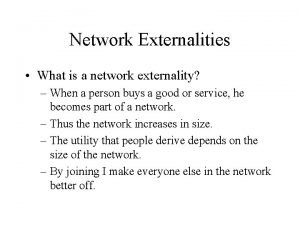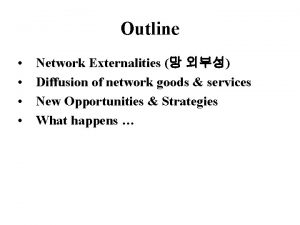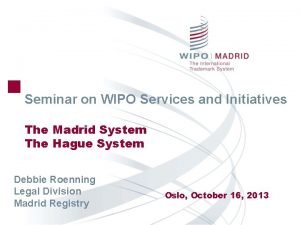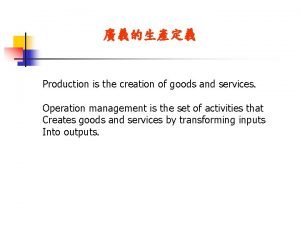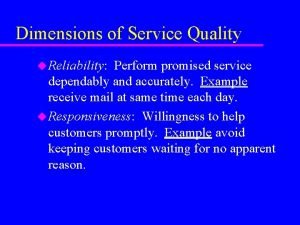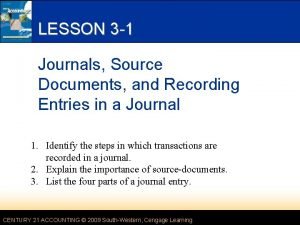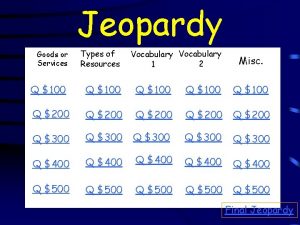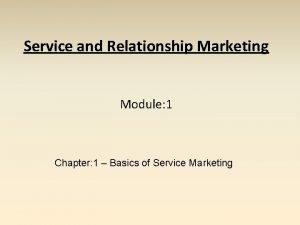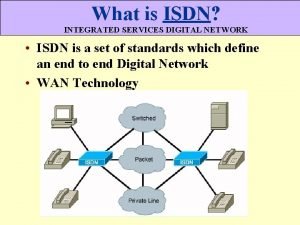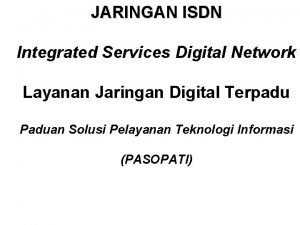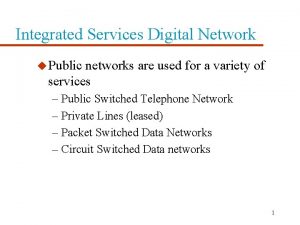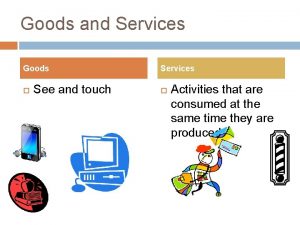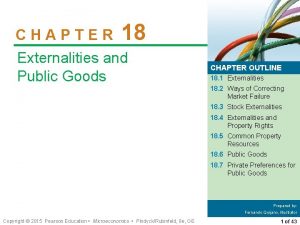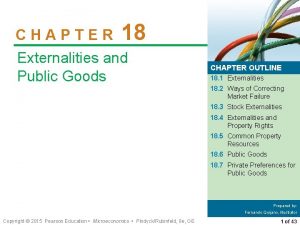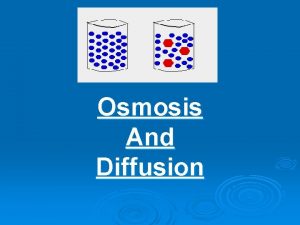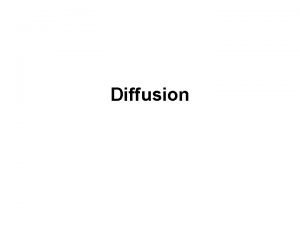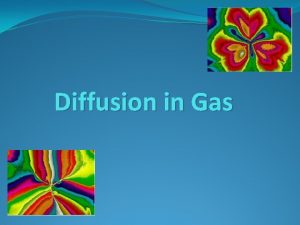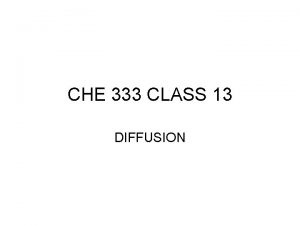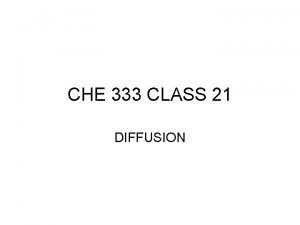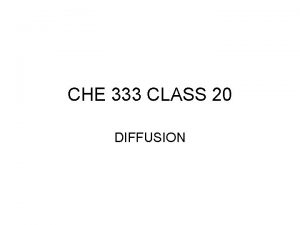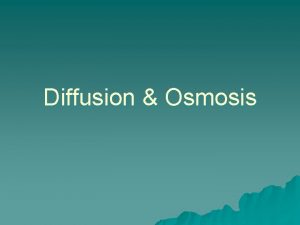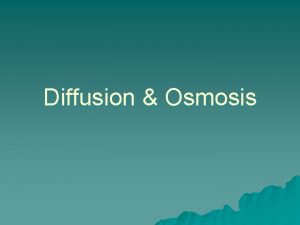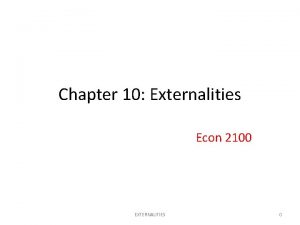Outline Network Externalities Diffusion of network goods services










































- Slides: 42

Outline • • Network Externalities (망 외부성) Diffusion of network goods & services New Opportunities & Strategies What happens …

I. Network Externalities

1. Externalities in economics • Externality exists when the production or consumption of a good directly affects businesses or consumers not involved in buying and selling it and when those spillover effects are not fully reflected in market prices. • 재화를 사고파는 당사자 이외의 사람이나 비지니스에 직접 영향 • 그러한 파급효과가 시장 가격에 모두 반영되지 않는 현상

2. Typology of Externalities Hare/Software Paradigm Network Externalities (+) Development Effect Demand Side Supply Side Congestion (-) Pollution

3. Negative Externalities • Negative externality is a cost imposed on a person by the actions of others, without the consent of the person who bears the cost (ex. air pollution in industrial areas).

4. Positive Externalities • A positive externality is a benefit received by a person as a result of the actions of others.

5. Network Externalities • The Utility that a subscriber drives from a communications service increases as others join the system (Rohlfs, 1974) • The increasing utility that a user derives from consumption of a product as the number of other users who consume the same product increases (Katz & Shapiro, 1985) • The benefit (i. e. , network externalities) that a consumer derives from the use of a good often is an increasing function of the number of other consumers purchasing compatible items. In the case, there is a direct externality: the more subscribers there are on a given communications network, the greater are the services provided by that network (Katz & Shapiro, 1986) Network externalities can influence consumers’ decision whether to adopt a new technology and producers’ decision whether to standardize their products.

6. Metcalfe’s law • If there are n people in a market, and the value of the network to each of them is proportional to the number of other users, then the total value of the network (to all the users) is proportional to n x (n-1) = n 2 – n. • • • If # of users: 10 If # of users = 100 Increase in the # of user = 10 x value: 102 – 10 = about 100 value of the network: 1002 – 100 = 10000 Increase in the value of network = 100 x

7. Demand side economies of scale • Network effect = network externalities = demand-side economies of scale • The value of connecting to a network depends on the number of other people already connected to it. • Key factor: positive feedback

8. Indirect Externalities: HW-SW pdm • A system can be any combination of a durable good and associated goods or services that perform some desired function • Virtual network: owners of compatible hardware and software systems constitute a virtual network. . • Mechanism: • Adoption of hardware by one purchaser confers external benefits on other users of the same software. Suppliers may therefore take advantage of scale economies and provide more varieties of software. • The availability of more diverse and inexpensive software enhances the value of the existing users’ hardware.

9. Dark Side of Network Externalities a. b. c. d. Critical mass Multiple equilibria (next time…) Monopoly Lock-in into inferior good (Path dependency)

a. Critical Mass • Critical mass is the milestone which leads to the promising future (virtuous cycle)


b. Multiple Equilibria • No one knows the future: equilibrium may not exist, or multiple equilibria may exist and the fundamental theorems of welfare economics may not apply. • Networks may not reach optimal size, because purchasers do not take account of social benefits of their purchases, and markets may converge on an inferior standard that effectively excludes better products.

b-1. Rohlfs model: Multiple equilibria For simplest model, let potential network value (V) of a network distributes uniformly from 0 to 1. Assume: (1) that only those who estimate value to them to be more than V subscribe and (2) that total number of population is 1. Then, subscription ratio r = (1 - V) / 1. So V = 1 - r. ---------- (1) On the other hand, a marginal subscriber expects that his benefit is equal to his subscription cost. Usually subscription cost is set as a constant (P). And the benefit which the marginal subscriber expects is calculated as (r x V). So P=rx. V ---------- (2)


b-2. Interpretation of Rohlf’s model: At equilibrium A, a small network is established, where a limited number of customers can enjoy benefits. At point B, however, the subscription ratio is higher than A, which qualifies point B as being the best equilibrium at the same subscription cost, P. Point A implies the existence of “critical mass”. One example in real world is introduction of videotex: French Minitel – which has already exceeded “critical mass” All other countries’ videotex networks, which don’t exceed critical mass point. without passing critical mass, socially optimal size of network would not established. Same implication was given from the word, externalities. market failure (I)

c. Monopoly • If critical mass was passed, network externalities lead to monopoly though positive feedback. Ex) VCR War: VHS vs. Beta max QWERTY vs. Dvorak Windows vs. Mac • Key problem: anti-trust implication • monopoly in technology today leverages the market share in technology tomorrow. Ex) Microsoft operating system – browser market. MS browser – e-business tomorrow

d. Lock-in into inferior good • With the advantage of huge installed base and first mover, positive feedback can make markets converge on an inferior good tomorrow. Ex) QWERTY Key board display VHS Dos Windows • Path Dependent 우주왕복선 추진 로켓의 폭: 4피트 8. 5인치 기차 선로 영국의 석탄 운반용 마차 선로 말 두마리가 끄는 전차 폭에 맞춰진 로마 도로 폭

II. Competition Strategies

1. Key point to compete • Expansion of installed base • Business in the presence of network externalities is a war to expand installed base • 망 외부성이 있는 재화를 거래하는 시장에서 가장 중요한 것은 가입자 기반의 확대

2. Strategic choices • Compatibility vs. Incompatibility • Openness vs. Control • 호환성 허용 여부 • 개방 vs 폐쇄

3. Strategic Tools a. Give away: browser war (first Netscape, next MS IE) b. Ignorance of piracy (illegal of DOS) c. Alliance d. Subsidy e. Manipulation of expectation (Tactical tools: Pre-announcement & Forming reputation)

e. Example of Expectation-Work 6/91




2. 경쟁의 축 이동 Wintel Google Open Managed Opne Web App Search App Ad Sense 생태계 구성원 의 확대 Apple Android Google TV i. Ad SNS Facebook Twitter Pages/ Graph Prompted line OS X i. TV I. O. Conference WWDC f 8 (Facebook)

3. Key points to watch • Open vs. Closed (or Managed Open) • Compatibility choice (w/ Flash) • Give away (MS 전략 Google Android) • Path dependency (Google line up vs i. Tune …) • Manipulation of expectation (Thought on Flash) • Hardware – Software Paradigm: 개발자 회의 Pre-announcement


4. Net Ext. & API Why so fast growth?

4. Net Ext. & API Why so fast growth? Facebook Prepares To Announce 500 Million Users

4. Net Ext. & API Universe of Facebook Open Graph 50, 000 Web Sites A Week

4. Net Ext. & API Universe of Twitter

4. Net Ext. & API How about Cyworld? • Open vs. Control, again • Sharing of Installed-base: Open or Collaboration?

5. Expectation Works? Screen shot of i. Phone



5. Expectation Works? Apple’s response

5. Expectation Works? Does it work?

6. 변화 전망 • Platform의 병존 (과거의 반복) Google’s Mass vs. Apple’s High end market Webtropolis vs. Suburban • 모바일광고의 dominance & 다양한 BM 병존 Google’s Search-based LBS vs. App vs. SNS Local Portal’s Shrinkage • New device comes with new BMs Apple’s i. Tunes, App Store, i. Books Google’s TV & i. TV • Managed Opne 전략, (당분간) 유효 Apple’s Success w/ Tri-vergence Failure of Linux

 Externalities and public goods microeconomics
Externalities and public goods microeconomics Consumer products classifications
Consumer products classifications What is network externality
What is network externality Myspace
Myspace Simple diffusion
Simple diffusion Relocation and expansion diffusion
Relocation and expansion diffusion Externalities in environmental economics
Externalities in environmental economics Externalities problems and solutions
Externalities problems and solutions Health externalities
Health externalities Progressive tax examples
Progressive tax examples Merit goods vs public goods
Merit goods vs public goods Publik goods
Publik goods Wipo romarin madrid monitor
Wipo romarin madrid monitor Sale of goods and supply of services act 1980
Sale of goods and supply of services act 1980 What is the term for the creation of goods and services
What is the term for the creation of goods and services Marketing goods and services
Marketing goods and services Design of goods and services
Design of goods and services Product line length
Product line length Quality dimensions of goods and services
Quality dimensions of goods and services Quality dimensions of goods and services
Quality dimensions of goods and services Design of goods and services
Design of goods and services Goods and services difference
Goods and services difference Goods and services exempted from vat in rwanda
Goods and services exempted from vat in rwanda Developing and pricing goods and services
Developing and pricing goods and services A form for recording transactions in chronological order
A form for recording transactions in chronological order Goods and services vocabulary
Goods and services vocabulary Design of goods and services
Design of goods and services Means acquiring goods and or services
Means acquiring goods and or services Servuction model in service marketing
Servuction model in service marketing Production of goods and services
Production of goods and services Goods and services examples
Goods and services examples On each journal page, the date is written
On each journal page, the date is written Role of operations manager
Role of operations manager How to make a sandwich paragraph
How to make a sandwich paragraph Network goods
Network goods Intserv vs diffserv
Intserv vs diffserv Wake county human services community services center
Wake county human services community services center Integrated digital services network switch
Integrated digital services network switch What is cpesn
What is cpesn Nss network security services
Nss network security services Kanal isdn
Kanal isdn Integrated digital services network
Integrated digital services network Network services
Network services


